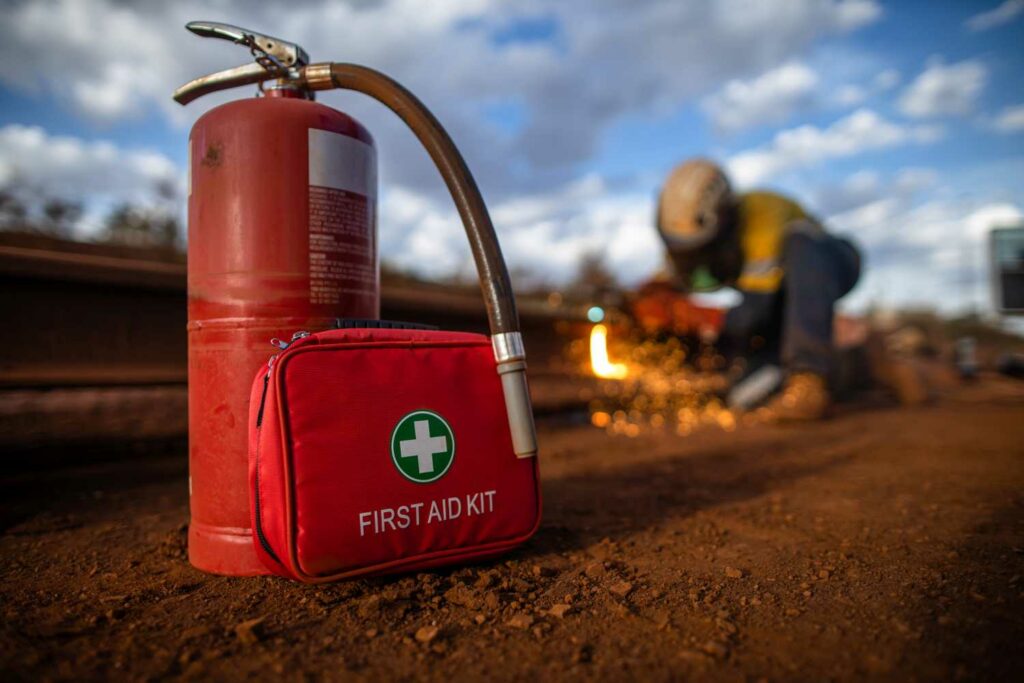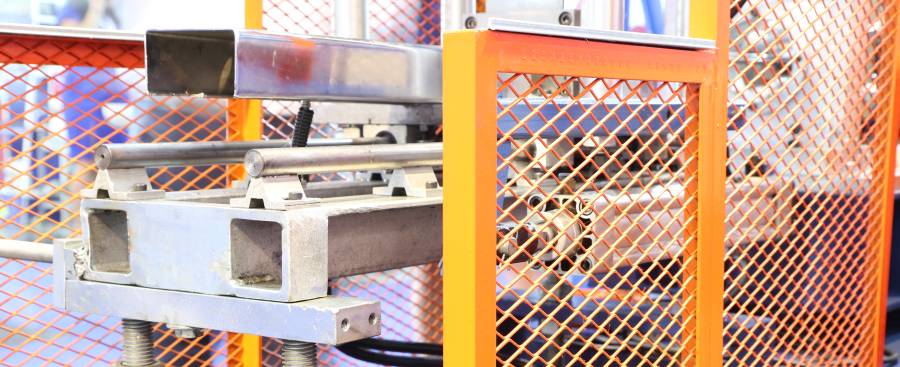
Top 10 Workplace Safety Topics for Meetings
Workplace safety is crucial in every industry, and it is essential to regularly educate and remind employees about the importance of safe practices. One way to do this is by addressing workplace safety topics at meetings. Here are the top 10 workplace safety topics to address at meetings and real-life examples of what can go wrong:
1) Hazard Communication
Hazard Communication sits in at number one of our top ten workplace safety topics; empowering employees with awareness always pays off. Hazard communication ensures team members understand the risks associated with their work and know how to protect themselves. Effective hazard communication helps prevent accidents, illnesses, and injuries caused by hazardous chemicals or materials.
The Occupational Safety and Health Administration (OSHA) has specific requirements for hazard communication that employers must follow. These requirements include:
- Hazard determination: Employers must identify and evaluate the hazards associated with the chemicals and materials used in the workplace.
- Material safety data sheets (MSDS): Employers must obtain MSDSs from manufacturers or distributors for all hazardous chemicals and materials used in the workplace. MSDSs contain information on the physical and chemical properties of the material, health effects, and safety precautions.
- Labeling: Employers must ensure that all hazardous chemicals and materials are properly labelled with information about the hazard and appropriate precautions.
- Employee information and training: Employers must provide to employees on the hazards associated with the chemicals and materials used in the workplace, as well as appropriate safety measures.
Examples of what can go wrong without effective hazard communication include:
- Exposure to toxic chemicals: Without proper communication and training, employees may not know the risks associated with handling hazardous chemicals, leading to exposure and potential health problems.
- Chemical reactions: If incompatible chemicals are mixed or stored improperly, they can react and create dangerous conditions, such as explosions, fires, or toxic gases.
- Ignoring warning signs: If employees are not trained to recognize warning signs, they may not take appropriate action when they see them, leading to accidents and injuries.
- Improper storage and handling: Without proper communication and training, employees may not know how to properly store and handle hazardous materials, leading to spills, leaks, and other accidents.
2) Fire safety
Fire safety may seem obvious, but like all these workplace safety topics it should never be overlooked. It is essential for employers to have a comprehensive fire safety plan in place to minimize the risk of a fire and ensure that everyone in the workplace knows what to do in the event of a fire emergency.

Here are some examples of what can go wrong with fire safety in the workplace:
- Lack of fire prevention measures: Without , such as regular maintenance of electrical equipment, proper storage of flammable materials, and training on fire hazards, the risk of a fire can be greatly increased.
- Poorly maintained fire suppression systems: Fire suppression systems, such as sprinklers and fire extinguishers, must be properly maintained and tested to ensure that they will function correctly in the event of a fire.
- Inadequate emergency exits: In the event of a fire, it is crucial to have clear and accessible emergency exits. If emergency exits are blocked or not clearly marked, it can impede evacuation and result in injuries or deaths.
- Lack of fire drills and training: Without regular fire drills and training on fire safety procedures, employees may not know what to do in the event of a fire emergency, leading to confusion and potentially dangerous situations.
To prevent these and other issues, it is important for employers to implement a comprehensive fire safety plan. This may include:
- Regular maintenance and inspection of electrical equipment and wiring to prevent electrical fires.
- Proper storage of flammable materials, including keeping them away from heat sources and ensuring they are properly labeled.
- Installation and maintenance of fire suppression systems, such as sprinklers and fire extinguishers, and training employees on their proper use.
- Clear and accessible emergency exits, with regular testing to ensure that they function correctly.
- Regular fire drills and , including evacuation procedures, use of fire suppression systems, and first aid.
- Designation of specific employees to be responsible for fire safety, including monitoring and reporting potential fire hazards.
3) Ergonomics
3rd in our workplace safety topics is Ergonomics. Ergonomics is the study of designing workplaces and work environments to optimize human performance and reduce the risk of workplace injuries and musculoskeletal disorders. By ensuring that the work environment is properly designed and set up to fit the needs of workers, employers can help reduce the risk of injuries and improve productivity.
Here are some examples of what can go wrong with poor ergonomics in the workplace:
- Repetitive strain injuries: Repetitive motions, such as typing or using a mouse, can cause repetitive strain injuries, such as carpal tunnel syndrome.
- Back and neck pain: Poor posture and incorrect lifting techniques can lead to back and neck pain.
- Eye strain: Poor lighting or glare on computer screens can cause eye strain and headaches.
- Fatigue and discomfort: Workspaces that are uncomfortable or poorly designed can lead to fatigue and discomfort, which can reduce productivity and increase the risk of workplace injuries.
To prevent these and other issues, it is important to implement proper ergonomics in the workplace. This may include:
- Proper workstation design: Workstations should be designed to accommodate the needs of workers, such as adjustable chairs and desks, and proper positioning of monitors, keyboards, and mice.
- Training on proper lifting techniques: Workers should be trained on proper lifting techniques to prevent back and neck injuries.
- Proper lighting: Proper lighting can reduce eye strain and headaches.
- Regular breaks: Workers should be encouraged to take regular breaks to stretch and move around to prevent fatigue and discomfort.
- Use of ergonomic equipment: Ergonomic equipment, such as standing desks or ergonomic keyboards, can help reduce the risk of workplace injuries and improve productivity.
4) Electrical Safety
Electrical hazards can result in serious injuries or even death and can have a devastating impact on the workplace and its employees. Electrical workplace safety topics should be brought up frequently anywhere electricity is prevalent. It is essential for employers to have a comprehensive electrical safety plan in place to minimize the risk of electrical hazards and ensure that everyone in the workplace knows what to do in the event of an electrical emergency.

Here are some examples of what can go wrong with electrical safety in the workplace:
- Overloaded electrical circuits: Overloading electrical circuits can lead to overheating and electrical fires.
- Faulty electrical equipment: Faulty electrical equipment can cause electrical shocks, electrocution, or fires.
- Inadequate grounding: Inadequate grounding can lead to electrical shocks or electrocution.
- Lack of proper personal protective equipment (PPE): Workers who work with electrical equipment may need to wear PPE, such as insulated gloves, to prevent electrical shocks.
To prevent these and other issues, it is important for employers to implement a comprehensive electrical safety plan. This may include:
- Regular inspection and maintenance of electrical equipment and wiring to prevent electrical hazards.
- Proper use and storage of electrical equipment, including unplugging equipment when not in use and keeping it away from water sources.
- Installation of ground-fault circuit interrupters (GFCIs) in areas where water is present, such as bathrooms and kitchens.
- Training on electrical safety procedures, including proper use of electrical equipment and PPE, and what to do in the event of an electrical emergency.
- Designation of specific employees to be responsible for electrical safety, including monitoring and reporting potential electrical hazards.
5) Personal Protective Equipment (PPE)
Another of our top ten workplace safety topics is Personal protective equipment (PPE). PPE is designed to protect workers from potential workplace hazards that cannot be eliminated through engineering and administrative controls. PPE includes a wide range of equipment such as safety helmets, gloves, safety glasses, respirators, and full-body suits. The use of PPE is essential in many workplaces to prevent injuries and illnesses, and it is important that employers provide the necessary PPE and ensure that workers are trained on how to use it properly.
Here are some examples of what can go wrong without proper use of PPE in the workplace:
- Eye injuries: Exposure to flying particles, chemicals, or intense light can cause serious eye injuries, including blindness.
- Hearing loss: Exposure to loud noise can cause permanent hearing loss if not properly protected by earplugs or earmuffs.
- Respiratory problems: Exposure to dust, chemicals, or other harmful substances can cause respiratory problems, including lung cancer and other respiratory diseases.
- Head injuries: Falls, impact from falling objects, and other hazards can cause head injuries, including traumatic brain injuries.
To prevent these and other issues, it is important to implement proper use of PPE in the workplace. This may include:
- Providing workers with the necessary PPE: Employers should provide workers with the necessary PPE to protect them from potential workplace hazards.
- Training on how to use PPE properly: Workers should be trained on how to use PPE properly, including how to put it on and take it off, how to adjust it for proper fit, and how to maintain it.
- Regular inspection and maintenance of PPE: PPE should be regularly inspected and maintained to ensure that it is in good condition and provides adequate protection.
- Encouraging workers to report problems with PPE: Workers should be encouraged to report any problems with their PPE to their supervisor or safety manager.
6) Slips, Trips, and Falls
Number 6 is a workplace safety topic everyone can relate to. Slips, trips, and falls are a common cause of workplace injuries and can occur in almost any workplace. These accidents can result in serious injuries such as broken bones, head injuries, back injuries, and even fatalities. Employers have a legal and moral responsibility to provide a safe working environment for their employees, and preventing slips, trips, and falls should be a top priority.

Here are some of the main causes of slips, trips, and falls in the workplace:
- Slippery floors: Spills, wet floors, and other hazards can cause slips and falls. This is particularly common in areas where liquids are used, such as kitchens, bathrooms, and factories.
- Tripping hazards: Tripping hazards such as loose carpeting, cords, and cluttered walkways can cause trips and falls.
- Uneven surfaces: Uneven or poorly maintained surfaces, such as potholes, cracks, or loose tiles, can cause trips and falls.
- Poor lighting: Poor lighting can make it difficult for workers to see potential hazards, increasing the risk of slips, trips, and falls.
- Inadequate footwear: Wearing inappropriate footwear, such as shoes with smooth soles or high heels, can increase the risk of slips, trips, and falls.
To prevent slips, trips, and falls in the workplace, employers can take several measures, including:
- Implementing a cleaning and maintenance program: Regular cleaning and maintenance of floors can prevent slips and falls. Any spills or wet areas should be immediately cleaned up and clearly marked with warning signs.
- Keeping walkways clear: Walkways should be kept clear of clutter, cords, and other obstacles that can cause trips and falls. Workers should be trained to keep their work areas clean and tidy.
- Proper lighting: Adequate lighting should be provided to ensure that workers can see any potential hazards that could cause slips, trips, and falls.
- Providing appropriate footwear: Employers should provide workers with appropriate footwear for the job they are doing. Slip-resistant shoes or boots with good traction can help prevent slips and falls.
- Installing handrails and guardrails: Handrails and guardrails can provide support and protection to workers in areas where slips, trips, and falls are common.
7) Machine Guarding
Improperly guarded machinery can cause serious injuries, including amputations, fractures, and lacerations. It is most certainly a valuable workplace safety topic. According to the Occupational Safety and Health Administration (OSHA), machine guarding violations are among the top 10 most frequently cited OSHA violations.

Here are some examples of what can go wrong with machine guarding in the workplace:
- Moving parts: Machines with moving parts such as saws, presses, and conveyors can cause serious injuries if the operator or other workers come into contact with them.
- Pinch points: Pinch points are areas of a machine where workers’ body parts can get caught or crushed. Examples include the point where two parts come together or where a part moves against a stationary object.
- Flying debris: Some machines, such as grinders and sanders, produce flying debris that can cause eye injuries or lacerations.
Workplace safety topics are only as good as their preventative measures. To prevent these aforementioned issues, it is important to implement measures to properly guard machinery in the workplace. This may include:
- Installing physical barriers: Physical barriers such as guards, barriers, and enclosures can protect workers from moving parts and pinch points. These barriers should be made of sturdy materials that can withstand impact and should be securely attached to the machine.
- Providing proper training: Workers should receive proper . This includes understanding how to properly use guards and barriers.
- Conducting regular inspections: Machinery should be regularly inspected to ensure that guards and barriers are in place and functioning properly.
- Providing personal protective equipment: Workers should be provided with appropriate personal protective equipment, such as safety glasses and gloves, to protect against flying debris and other hazards.
- Following OSHA regulations: Employers must comply with , which include requirements for proper guarding, maintenance, and training.
8) Workplace Violence
Workplace violence can occur in any workplace and can take many forms, including physical assault, threats, intimidation, and harassment. According to the National Safety Council, workplace violence is the second leading cause of occupational fatalities in the United States. Broaching this workplace safety topic at your next safety meeting could give employees vital incite into preventing these incidents and mitigating common factors.
Here are some examples of what can go wrong with workplace violence in the workplace:
- Physical assault: This includes acts of violence such as hitting, punching, or kicking. It can also include the use of weapons.
- Threats: Threats of violence can cause fear and anxiety among employees. This can include verbal threats, written threats, or threats made through electronic communication.
- Harassment: Harassment can take many forms, including sexual harassment, bullying, and discrimination. It can create a hostile work environment and can cause emotional distress for employees.
To prevent workplace violence, it is important for employers to implement measures to create a safe and secure work environment. This may include:
- Developing a workplace violence prevention plan: Employers should develop a plan that outlines procedures for preventing and responding to workplace violence incidents.
- Conducting background checks: Employers should conduct background checks on potential employees to identify any history of violent behavior.
- Providing training: Employers should provide training to employees on how to recognize and respond to workplace violence. This includes how to report incidents and how to protect themselves.
- Implementing security measures: This may include installing security cameras, alarm systems, and secure entry points.
- Creating a culture of respect: Employers should create a workplace culture that promotes respect and civility. This can help prevent incidents of harassment and bullying.
9) Driving Safety
9th in our workplace safety topics is Driver Safety. Whether it’s delivering goods, travelling to appointments, or visiting job sites, driving is an essential part of many jobs. However, driving can also be dangerous, and motor vehicle accidents are a leading cause of work-related fatalities.
Here are some examples of what can go wrong with driving safety in the workplace:
- Distracted driving: Distracted driving is a leading cause of accidents, and it can include texting, talking on the phone, eating, or adjusting the radio.
- Speeding: Speeding is a common cause of accidents, and it can be particularly dangerous in work zones or on roads with heavy traffic.
- Fatigue: Fatigue can impair a driver’s reaction time and decision-making ability. It can be a particular risk for employees who drive long distances or work irregular hours.
To prevent accidents and protect employees, it is important for employers to implement measures to ensure safe driving practices. This may include:
- Establishing driving policies: Employers should establish policies that outline safe driving practices and expectations for employees who drive for work purposes. This may include limits on cell phone use, requirements for regular rest breaks, and rules for vehicle maintenance and inspection.
- Providing driver training: Employers should provide training for employees who drive for work purposes. This may include defensive driving techniques, hazard awareness, and strategies for avoiding distractions.
- Conducting regular vehicle inspections: Employers should regularly inspect vehicles to ensure that they are properly maintained and in good working order. This includes checking tires, brakes, and other critical components.
- Monitoring driving behavior: Employers can use telematics and other monitoring tools to track driving behavior and identify areas for improvement. This can help employees understand their own driving habits and take steps to improve their safety.
- Encouraging a culture of safety: Employers should encourage a culture of safety in which employees feel empowered to report safety concerns and work together to improve driving practices.
10) Emergency Preparedness
Emergency Preparedness training makes it into everyone’s workplace safety topics list. Emergencies can happen at any time, whether it’s a natural disaster, a workplace accident, or a medical emergency. It is critical for employers to have a plan in place to protect employees and respond to emergencies quickly and effectively.

Here are some examples of what can go wrong with emergency preparedness in the workplace:
- Lack of planning: Without a plan in place, employees may not know what to do in the event of an emergency, which can lead to confusion and delays in response.
- Inadequate training: If employees are not trained on emergency procedures, they may not know how to respond to emergencies effectively, which can put themselves and others at risk.
- Insufficient communication: During an emergency, communication is critical. If communication systems fail or are not in place, employees may not receive important information or instructions.
To ensure that employees are safe in the event of an emergency, it is important for employers to implement measures to prepare for emergencies. This may include:
- Developing an emergency preparedness plan: Employers should develop a plan that outlines procedures for responding to emergencies, including evacuation procedures, communication systems, and emergency contacts.
- Conducting drills and exercises: Employers should conduct drills and exercises to test the effectiveness of the emergency preparedness plan and identify areas for improvement.
- Providing training: Employers should provide training to employees on emergency procedures, including evacuation, first aid, and the use of emergency equipment.
- Establishing communication systems: Employers should establish communication systems that can be used in the event of an emergency, such as public address systems, text alerts, or emergency radios.
- Maintaining emergency equipment: Employers should maintain emergency equipment, such as first aid kits, fire extinguishers, and emergency lighting, to ensure that it is in good working order and readily accessible.









































